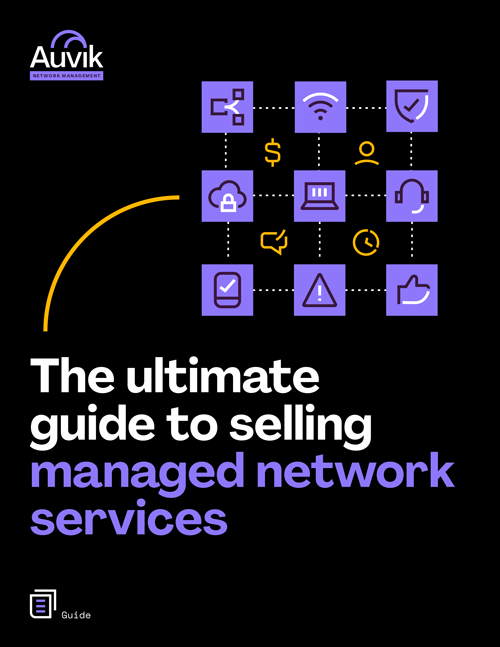You’ve probably heard the term land and expand before. Today, we’re adding a third term: Land, Expand, and Retain. As an MSP or SaaS vendor, it’s an effective strategy for business growth. While each one encompasses its unique approach, each of the three stages interconnects with each other, profoundly impacting a successful customer acquisition journey.
Let’s look at a number of scenarios under each of these tenants, and see how Auvik can provide specific solutions mapped to MSP customers’ needs and MSP’s bottom lines.
1. Land
Landing a customer is no easy task. There is tons of effort put into it before even meeting the prospects: lots of money has been spent through brand marketing, events, campaigns, and more. Finally, sales teams get a list of target clients to work with. The last thing the organization wants to see is the sales team not executing the plans and burning the opportunities.
This is the same in the MSP world. Think of it: you got a referral from another client with a reputation on the line, so how do you deliver value on the first meeting? How would a prospective client instantly understand that you are different from every other pitch? How would you quickly understand what kind of customer environment you are working with in order to recommend the best services for them— and not misquote? These are all the things that our MSP partners worry about for their initial engagements with customers.

Your Guide to Selling Managed Network Services
Get templates for network assessment reports, presentations, pricing & more—designed just for MSPs.
Auvik Pro Tip: Network Audits Seal the Deal
Here at Auvik, many successful partners use our tool for a quick network audit, as the collector can be easily deployed on a windows device or virtual machine. From there, typically within 30 minutes, Auvik will return valuable information, including:
- A nearly complete network topography
- A visual topology map, updated in real-time
- The current network configuration
Compare that to manually looking up serial numbers behind switch stacks, untangling wires, and tracing unlabelled ports, or investigating why there are so many different subnets/VLANs for a supposedly simple network. It’s a lot of time saved, and a big credit to you in the eyes of a prospective client!
Using Auvik as a network assessment tool can also help MSPs fight a lot of other battles too:
- Taking the customer’s word on what they have, misquoting them, and bleeding margin down the road
- “No documentation from the client’s previous MSP”
- Repetitive network performance issues that lead them to constantly call for urgent help
Charge a fee for your assessment, recommend the repair needed, and deliver a report of the findings. Almost all other professional services charge an initial assessment fee, but IT consulting somehow tends to be undervalued in many situations like this. Auvik’s partner portal has resources that would help with landing the customer, such as our network assessment template.
2. Expand
The next phase of land and expand involves just that: Expanding services becomes important once the client is under management. With constantly changing technology and business operations, a customer’s needs will likely be changing as well.
Considering adding network monitoring as an a-la-carte service to a client?
Could be some ongoing customers care about their network performance more now because they depend on more cloud services. Maybe the client is co-managed, and network visibility would be greatly beneficial to the internal IT team. If the audience is technical, they’ll instantly understand the Auvik value:
- Being able to replace aging, on-premise network monitoring solutions that require dedicated resources to maintain
- Reduced hardware cost
- Eliminating a single point of failure, as not everyone knows how to run the current platform
- Removing friction between the internal IT team and the MSP when escalating problems
- More streamlined network documentation process.
Maybe your customers want to have a centralized way to see all devices Syslog? Has the client ever asked why is the network slow and wished to see how traffic is being used on the network? Auvik has answers to both of these additional services that MSPs can add to their portfolio.
Why not consider bundling the network monitoring solution into a security package? After all, how can you control security and compliance when you don’t know what’s out there on the network?
3. Retain
Lastly, retaining all your existing clients while continuing to acquire more, all with a lean team, is every MSP’s goal. Some of the Auvik ROI may not be directly translated to dollar amounts right away but can be realized once the product is fully adopted. For example, in any fully managed agreement, does the Service Level Agreement (SLA) include network uptime and monitoring? How do you deliver what’s in the SLA to continue the trusted relationship with the customer?
What about…?
Has there been a situation where you had to go onsite to document or troubleshoot the network because of a lack of network insight? With gas prices at an all-time high, Auvik’s remote visibility would eliminate much of the wasted trips just to document or troubleshoot network performance issues.
Does the customer ask for a report that shows their network uptime and performance? Auvik allows custom user permissions so customers can log in and see the current network status and have access to reports.
Is it difficult/expensive to hire a network specialist? Auvik is very intuitive and turnkey, which simplifies Network operation and allows level 1 technicians to see more and respond quicker.
What about disaster recovery situations? Sure there’s data backup on the servers from other tools, but what about network restoration? In a complicated network where there might be many different VLANs, is there a backup on every switch’s running configuration? Auvik would remediate these risks by automating the configuration backup, allowing for simple rollback to a previous point in time first, then troubleshooting what happened at a later time. Avoiding long downtime for customers.
Auvik is a trusted and tested solution by thousands of MSPs, with an intuitive user interface, valuable and usable monitoring data, multi-tenant and vendor agnostics support, and layers of network visibility that would enable any MSP to know more about their customer’s network, and a key driver in executing a land and expand—and retain!—strategy.





